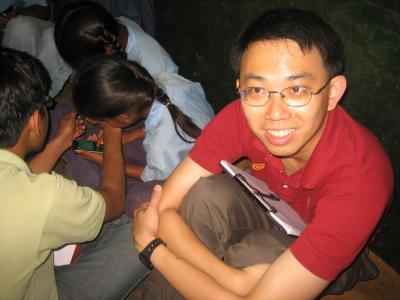Web Link(s)
Carnegie Mellon Expands Mobile Learning Project in India

PITTSBURGH—Carnegie Mellon University today announced the expansion of its Mobile & Immersive Learning for Literacy in Emerging Economies (MILLEE) project, which will gauge the effectiveness of mobile phone-based games for teaching English lessons to students in rural India. This new phase of the research project is made possible, in part, by a grant and a supply of 450 mobile phones provided by Nokia Research Center in Palo Alto, Calif.
Even today’s low-end mobile phones exceed the capabilities of the original IBM personal computer and thus could become important learning tools as wireless carriers extend their services into previously underdeveloped regions, said Carnegie Mellon’s Matthew Kam, assistant professor in the School of Computer Science’s Human-Computer Interaction Institute. He and his colleagues in the MILLEE project have spent six years designing educational games for mobile phones that are relevant to the culture of rural India. During the next two years, MILLEE will conduct a controlled study involving 800 children in 40 villages in the state of Andhra Pradesh.
“With Nokia’s assistance, we will be able to conduct field research that is more extensive and more rigorous than we could previously,” Kam said. “Our previous, smaller studies have shown that students have significant gains in learning when they use these games. By aiming to replicate these results in a much larger study, we anticipate that we can understand how to design and develop phone-based games to improve educational prospects for billions of people throughout the developing world.”
“Nokia is pleased to contribute to the MILLEE project,” said John Shen, lab director for the Nokia Research Center in Palo Alto. “The opportunities to use the mobile phone as an educational tool are unlimited, and Carnegie Mellon’s vision in this area is very aligned with that of Nokia’s.”
Kam and his students already are working on games that support a new English curriculum adopted by Andhra Pradesh schools this summer. Their goal is to have at least six and as many as a dozen games ready to deploy next year. If their field study is successful, they hope to establish partnerships with a growing number of content developers in India who are currently focused on educational programs for desktop computers.
“We’re trying to build an entire ecosystem of educational content developers around mobile learning, which does not currently have a critical mass,” Kam said. Shabnam Aggarwal, the project manager, will be relocating to India where she will oversee the research project and develop ties with content developers, wireless carriers and groups interested in implementing mobile learning programs. Aggarwal, who earned a degree in electrical and computer engineering at Carnegie Mellon, has experience on Wall Street and with non-governmental literacy programs in southeast Asia.
Despite their small screens and low computing power by today’s standards, mobile phones could become a major educational resource as wireless carriers and mobile phone manufacturers move aggressively to extend mobile phone penetration among rural consumers, Kam said. And if the educational benefits of mobile phones can be demonstrated convincingly, he added, those consumers will have an additional motivation for investing in mobile phone service, which will further spur mobile phone adoption.
The MILLEE project currently focuses on lessons that improve English skills because English is a power language in India and much of the developing world. Students must learn English, Kam explained, if they ever hope to pursue higher education or aspire to be part of the middle class. Yet, in many areas of the developing world, schoolteachers struggle to speak English and have difficulty helping their students to speak the language. Leonora Anyango-Kivuva, a veteran language instructor who speaks seven languages and holds a doctorate in international and development education from the University of Pittsburgh, contributes to MILLEE’s curriculum development efforts. Another collaborator is Maxine Eskenazi, associate teaching professor in Carnegie Mellon’s Language Technologies Institute, who is an expert in both second language acquisition and speech technologies.
Kam mentors a group of 20 students who comprise the backbone of the MILLEE project. They include Ph.D. student Derek Lomas who runs weekly design workshops and Ph.D. student Anuj Kumar who performs field trials with local partners. Graduate student Geeta Shroff conducts statistical analysis on mobile phone usage in rural India to identify improvements to the game designs. Computer science undergraduate Manoj Dayaram developed the foundational code for the upcoming games. Alex Kowalski, Gino Mancuso, Andrew Ngan, Daniel Rhim and Kyle Sondrock are developing three MILLEE games as their senior project in the Information Systems Program in the College of Humanities & Social Sciences; Raja Sooriamurthi, associate teaching professor, is their adviser. Anshul Chaurasia, Denny George, Chetan Gupta, Amol Jain, Manish Lohani, Nikhil Marathe and Kishan Patel – undergraduates at the Dhirubhai Ambani Institute of Information and Communication Technology in India – contribute to the game development and play testing as volunteers.
In addition to the expansion in India, MILLEE is working with Sue-Mei Wu, chair of Chinese learning initiatives in the Pittsburgh Science of Learning Center, a joint effort of Carnegie Mellon and Pitt, to expand its work to underserved regions in China. Mobile phone games will be tested in China to see if they can improve literacy in Mandarin. MILLEE is also being expanded to Kenya, where the games will be used to teach English.

